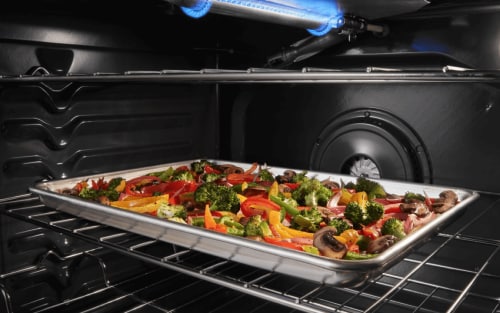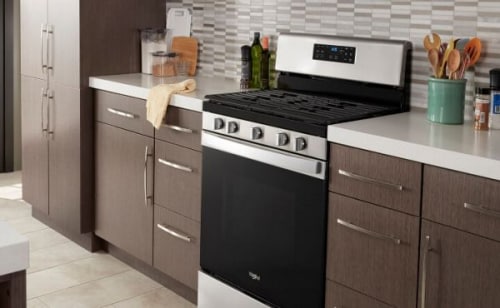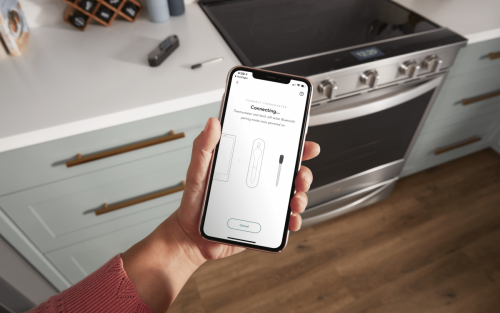
Self-cleaning vs. steam cleaning ovens: how to choose
With routine cleaning, you can help avoid unpleasant cooking odors from baked-on stains or spills in your oven. Both self-cleaning ovens and Steam Clean oven settings offer convenience as they save you time by cleaning the oven with just a few steps. Read on to learn how to choose the right kind of cleaning option for your oven.
What is a self-cleaning oven?
A self-cleaning oven uses either high temperatures or steam to help remove any residue and food leftover from previous baking or roasting. During a high temperature self-cleaning cycle, temperatures will reach upward of 800ºF to incinerate stuck-on grime, turning it into ash that can be wiped away with a wet cloth.
This cycle can take anywhere from 1.5 to 6 hours. It’s recommended that your kitchen is well-ventilated as this can help with any undesirable odors during the self-cleaning cycle. Keep in mind the oven door will remain locked until the cycle has ended and the oven has cooled.
What is the Steam Clean oven setting?
Using heat and water, ovens with a Steam Clean oven setting will soften light grime or food debris, making them easier to wipe away. It’s great for smaller messes and minor spills that happen when using your oven. The cycle tends to last for 1 to 1.5 hours for cleaning and cooldown, and temperatures typically max out at 400ºF.
To steam clean, you’ll pour around a cup of water on the floor of your oven, then select a steam cleaning cycle. As the oven heats, it turns the water to steam to help soften residue. After the cycle is complete, you'll need to wipe away any residual water and soil with a wet cloth. Note that the exact process may vary by model so be sure to reference your owner’s manual.
Should you choose an oven with self-cleaning or steam cleaning options?
It’s important to choose an oven that works for your cooking habits and fits into your cleaning routine. While they both have an automatic cleaning cycle, there are a few differences between a self-cleaning oven and an oven with a Steam Clean setting.
Benefits of self-cleaning ovens
Here are a few things to keep in mind when considering a self-cleaning oven:
The self-clean cycle incinerates tough, baked-on spills for a deep clean without using chemical cleaning products.
There is usually an automatic oven door lock for safety purposes during the high temperature heat cycle.
This cycle allows for easy cleanup—just wipe the debris away once it’s complete.
You may find that you can use this cycle less often than steam cleaning.
It’s great for keeping your oven clean if you frequently use it in your cooking routine.
Benefits of steam-cleaning ovens
Consider the following for ovens with a Steam Clean setting:
This option has a shorter, lighter cleaning cycle (around an hour compared to up to 6 hours for a self-clean cycle), which means less time spent waiting for the oven to clean.
There’s less need to ventilate or open windows as the oven likely won’t release excessive smoke or odors while cleaning.
It offers easy cleaning with no harsh chemicals—just wipe away the water and any loose residue after a cycle is complete.
Even though you may find that you use this cycle more often for light cleaning, it tends to use less energy because of the lower oven temperature.
It works well to keep your oven clean if you use it to cook less often.
Steam-clean vs. self-clean ovens: which is better for me?
An oven with a steam clean option offers a quicker, lighter cleaning in between deep cleans that’s ideal for routine cleaning. A self-cleaning oven cycle is longer, yet can tackle tougher, baked-on stains. It’s convenient for ovens that get regular use. Learn more about how to clean your oven.
Explore Whirlpool® Wall Ovens and Ranges
Whirlpool® wall ovens and ranges can handle the dirty work while you take care of the cooking with helpful features like steam-cleaning and Adjustable Self-Cleaning Technology on select models. Keep your kitchen looking its best by browsing the full collection of wall ovens and ranges from Whirlpool brand that can integrate seamlessly into your kitchen’s layout.
Learn more about different oven features from Whirlpool brand
-
 Conventional Oven vs. Convection: What’s the Difference? Learn the difference between a conventional vs. convection oven. Discover the pros and cons of standard and convection ovens for cooking, baking and roasting.
Conventional Oven vs. Convection: What’s the Difference? Learn the difference between a conventional vs. convection oven. Discover the pros and cons of standard and convection ovens for cooking, baking and roasting. -
 What Is a Dual Fuel Range Choosing a new range for your kitchen is exciting. Learn what a dual fuel range is, compare dual fuel vs. gas ranges and understand how dual fuel ranges work.
What Is a Dual Fuel Range Choosing a new range for your kitchen is exciting. Learn what a dual fuel range is, compare dual fuel vs. gas ranges and understand how dual fuel ranges work. -
 What Is a Smart Oven? Smart ovens, stoves and ranges can help make cooking faster and easier. Learn more about smart oven features to see what these appliances can do for you.
What Is a Smart Oven? Smart ovens, stoves and ranges can help make cooking faster and easier. Learn more about smart oven features to see what these appliances can do for you.


home heartbeat
Ready for more tips, home hacks and appliance guides?












